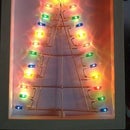Introduction: Let's Make a "Vacuum Tube Minion"
I'm often inspired by other makers.
This time I was inspired by this instructable and decided to give it a go.
I thought it would be fun to give it a "minion" appearance, with a HAL-9000 inspired glowing red eye.
Supplies
Here's what's needed for this build:
- A vacuum tube: I used a dead EM4 tube. It has a P8A socket that gives it a flat bottom end.
- 1.5mm brass rod
- A bit 8mm red led
- A 470 Ohms resistor (low current in order for the eye to faintly glow)
- A CR2032 battery holder (or a 3D-printed one)
- A 3D Printer
Step 1: The "eye"
I started by building the eye and battery holder, which was a bad idea since it made soldering the legs harder ; your're warned!
I started by forming the "eye holder" from a piece of 1.5mm brass rod.
Once I had it wrapping the tube tightly, I formed the 2 rods going down to the battery holder.
I stuck them on the tube with blue tape and a bit of super glue.
Then the "eye holder" was cut on the front side, in order to make room for the "nose LED".
I first used a very old rectangular LED, which didn't like soldering very close to the LED chip, and I blew it.
I had no spare so I bought a 8mm circular red led and truncated it to size using a dremmel cutting disk (Sorry, no photo).
It had to be small enough to fit in what I had laying around to make the eye: an old optics from a camera.
So the LED was sliced short, the pins cut very close to the case and soldered to the brass half-rings.
Step 2: The Battery Holder
The battery holder is printed from this model.
It's nice since it's the right shape and one of the connecting brass rods can easily be bent to make the minus battery contact.
The plus battery contact is made of one leg of the 470 Ohms resistor.
I had no small enough micro-swich to I used the other resistor leg as a switch. It's wrapped around the other brass rod when one want's to light-up the LED.
Step 3: The Bottom End
The bottom end is made with the attached model.
I then cut notches using a dremmel cutting disk in order to make room for the tube pins.
Attachments
Step 4: The Legs
This tube socket type does not allow for 6 symetrical legs, so I went for 4 legs only.
I first made a rough model of the leg using a bit of metal wire in order to determine the correct leg size and orientation. This is much easier to bend than brass wire.
I the formed the first leg and used the first one as a reference to make the others.
Then came the hard part: soldering the legs.
That's where I found out that I should have first soldered the legs since I could have made a cylindrical rig to help me get the right position.
So, I printed a schema of the socket, with 2 crossing lines where the legs would be soldered and used it as an alignment help.
I also used a "helping-hand" to keep the legs being soldered in place.
Getting the correct orientation and leg angle this way was a real pain...
As a final touch I stuck a bit of 3mm PLA filament as a "handle" at the end of the resistor leg used a switch.
That's it! A new beast has been added to my bestiary.
Step 5: Video Demo
A video demo is available here.






